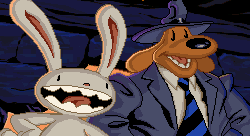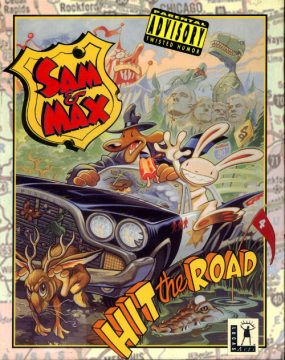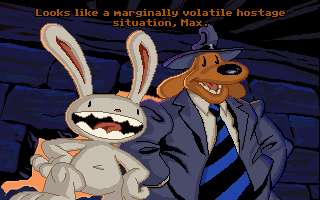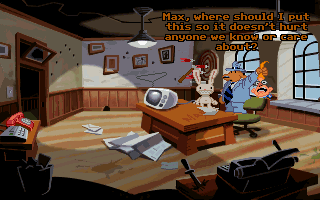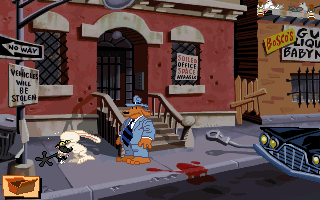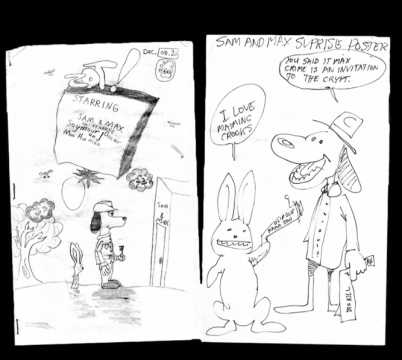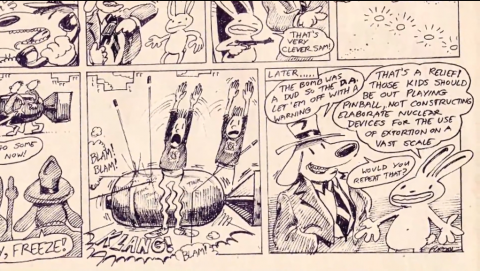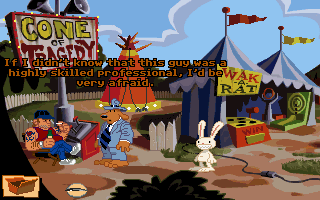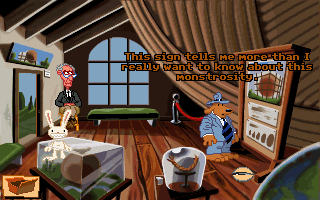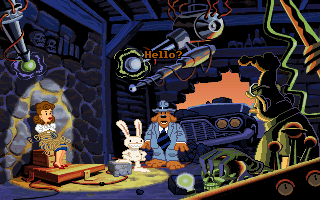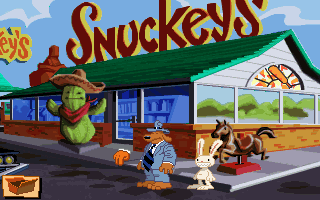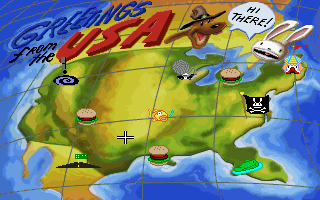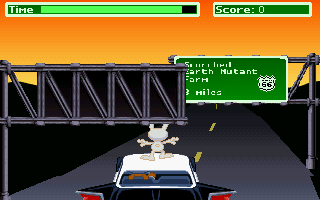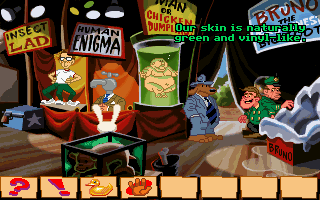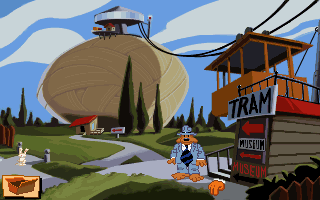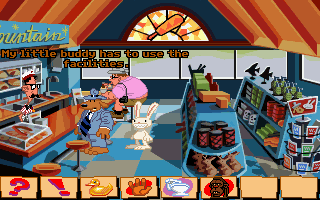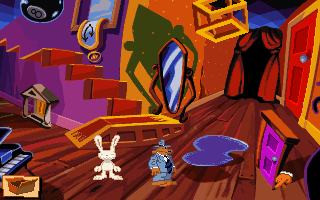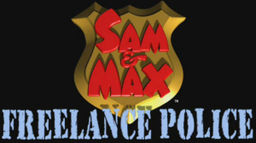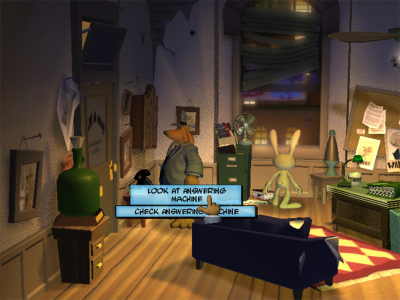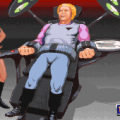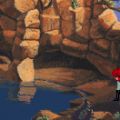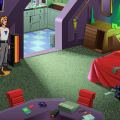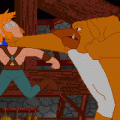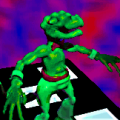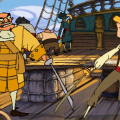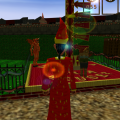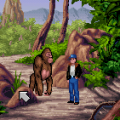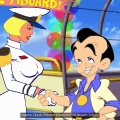Sam is a six foot tall canine shamus with a slick suit and a tie. Max is a psychotic grinning lagomorph with a penchant for mass destruction. Together they fight crime as “Freelance Police”, investigating numerous idiotic and baffling incidents as directed by a mysterious voice known only as The Commissioner. As a cartoonish mixture of detective mysteries and flat out lunacy, Sam and Max are one of the two most recognizable heroes in adventure gaming (if one could call them heroes, anyway).
Like most good buddy comedies, the charisma derives from the interplay between the eponymous heroes. Sam has a penchant for overtly long sentences, obtuse vocabulary, and elaborate non-sequiturs, all tendencies which frustrate Max to no end. Max is completely naked but apparently stores a massive Luger pistol on his person. (“It’s none of your damn business, Sam.” he replies when asked where he hides it, which has become a running joke.) A good amount of the banter are vague references to past, unseen events, leaving the player to fill in the implications. (“We don’t go upstairs.” “Not since the accident.”) They are both technically sociopaths, but lovable sociopaths, if there were indeed such a thing. Max is violent and homicidal, and approaches mayhem with a curiously child-like glee. Sam is calm and collected, relatively speaking. He’ll occasionally try to suppress Max’s id-like tendencies, but he’s also known to flip into a violent rage, when provoked.
Their craziness is, of course, their main draw. While Sam and Max will regularly drive in a manner most befitting drunkards, haphazardly fire their guns at anything they remotely deem a threat, or otherwise show a complete and total disregard for the safety of both themselves and others, it’s rare that you actually see any of the violence they purport to cause. Wanton destruction of property, yes, but actual shootings and beatings? Not really. Even when Max flies off the handle and ruthlessly pummels someone senseless, the camera obscures the action, with Sam delivering wincing commentary. While the violence is essentially Looney Tunes knocked up a couple of levels, the general aversion to showing anything truly horrifying keeps the duo innocuous and lovable, a balancing act that’s hard to pull off with consistent hilarity.
Sam and Max live in New York City, or at least some variation on it. It’s a dilapidated cesspool filled with garbage, crime, and disingenuous advertising, although most of the cynicism is played for laughs. While the heroes exist in a world mostly filled with humans, many of its inhabitants don’t think twice about a six foot tall talking dog and a diminutive but no less bizarre grinning rabbit. Indeed, the duo is relatively normal compared to talking rats, molemen, bigfoots, gigantic cockroaches, and robotic Abraham Lincolns.
There is little restraint in their antics, and pretty much anything goes in the world of Sam and Max. Between the comic, the cartoon and the games, the two travel to the moon, fight volcano gods, befriend the devil and defeat an evil Santa Claus. They drive an old DeSoto, which can travel everywhere around the globe (and beyond) with seemingly mystical powers. (Except for the time they travel into the outer space, which they accomplish by sticking numerous matches into their exhaust pipe and lighting them.)
Sam and Max got their start as doodles by a young aspiring comic book artist named Steve Purcell. Based on some crude drawings done by his little brother, they soon starred in their own small series of independent comic books, published beginning in 1987. Shortly thereafter, Purcell found professional work doing artwork for LucasArts on Zak McKracken and the Alien Mindbenders. His characters quickly became popular around the office, and Max’s visage can be found in many of their games. Eventually, they starred in short comics for The Adventurer, LucasArts’ product catalog, thereby making them sort-of official mascots. But their big break came with Sam and Max Hit the Road, their first computer game, released in 1993. It was a massive hit, and in 1997, Sam & Max even starred in their own cartoon series.
Despite their relative popularity, LucasArts was never able to follow up on it. A sequel was devised several years later, but was cancelled in 2004 due to “market conditions”. Shortly thereafter, Purcell re-obtained the license for his characters and hooked up with Telltale Games, a then-new studio comprised of some former LucasArts staff that focused on adventure games. Throughout three “seasons”, each consisting of five-to-six episodes digitally distributed online, Telltale resurrected the brand, and brought Sam & Max back into the limelight.
In the first game, Hit the Road, there’s something strange going on at the carnival! Bruno the Bigfoot has disappeared, and has kidnapped Trixie the Giraffe-Necked Girl. The owners are eager to have their sideshow attraction freaks returned to them, so Sam and Max are enlisted to hunt them down. They quickly end up following the tracks of one Conroy Bumpus, a diminutive, arrogant country music star with a penchant for hunting endangered species. Their investigations take them across the entire country, as they discover the true mystery behind Bruno’s disappearance, and save the Bigfoot race in the process.
Sam & Max Hit the Road is about one of the greatest American traditions – the tourist trap. Practically anyone that’s taken a road trip in the Great USA can recall any number of bizarre, inane attractions positioned on the long stretches of highway, existing to lure in unsuspecting families with promises of something truly wacky. The America portrayed in Sam & Max Hit the Road is filled with such attractions, usually exaggerated, but only slightly. Beyond their office in New York and the carnival, each location pays homage to various roadside disasters.
The World’s Largest Ball of Twine is exactly what it sounds like. (There’s a real one of these in Minnesota, but it’s not quite as large, nor do you need to take a cable car to reach the top.) The World of Fish is a glorified river bed. Bumpusville is a museum dedicated to Conroy Bumpus, not too far off from similar locations in the honor of Elvis Presley and (horrifyingly enough) Dolly Parton. The Celebrity Vegetable Museum will grow you a vegetable in the shape of any person, assuming you can provide them with a photograph. The Mystery Vortex is an enigma where the laws of physics don’t seem to apply. And the glorious, breathtaking Mount Rushmore has been demoted to a bungee jumping attraction/dinosaur park. The ubiquitous roadside gas station/restaurant Stuckey’s also appears in parody form as “Snuckey’s”, which are all (almost) spookily identical to each other and houses employees who graduate from the distinguished Snuckey University.
At first, there’s not a whole lot of guidance, as progress is made by finding various souvenirs or brochures, which opens up new locations on the United States map. Eventually your goals become clear – the first major one involves collecting bits of Bruno’s fur for a bizarre ritual concocted by the molemen, a strange hybrid race unique to the Sam & Max universe. Other tasks involve assembling a makeshift bigfoot costume, and finding arbitrary items to solve some kind of mystical totem pole puzzle. Like most LucasArts games, many involve finding a series of three-or-four different items, using various stuff scattered around each of the locations. One involves fetching a mood ring hidden in the World’s Largest Ball of Twine, which is obtained by combining a magnet, a golf-ball retriever, and a severed hand (which once belonged to Jesse James). Despite how cracked out that sounds, the puzzles actually aren’t too difficult by LucasArts standards, and the quest isn’t terribly long either.
It just also might be one of the funniest games LucasArts ever produced. They’ve made so many winners, so it’s hard to pick out one, but Sam & Max Hit the Road continuously hits the high notes with their dry, witty dialogue. The introduction sequence might be one of the best in the history the medium, where they briefly discuss what to do with a ticking time bomb obtained in the earlier scene. “Max, where should I put this so it doesn’t hurt anyone we know or care about?” Sam muses. “Out the window, Sam. There’s nothing but strangers out there.” Sure enough, he chucks out the window, where it detonates not-so-harmlessly off screen. “I sure hope there was no one on that bus.” “No one we know, at least…
Try to continuously pick up an immovable object and Sam will grow frustrated before bursting into tears, causing Max to directly threaten the player. At one point, Sam enters the world of virtual reality, rendered in extraordinarily crude polygons, a quaint reminder of how awful early 3D graphics looked. One of the best bits is a history lesson on naturalist John Muir, in the form of a song as performed by a series of mounted animal heads, complete with a blinking “Edutainment” sign.
The SCUMM interface in Hit the Road has been cut back a bit. The command window is gone, so the main visuals can take the full screen. All of the verbs have been condensed into five icons: “Walk”, “Look”, “Talk”, “Get” and “Operate”. Although you control Sam, Max also tags along, and playfully pokes and prods at bits of the background. He’s also useful for bits of puzzle solving. One of the first puzzles is to extract their orders from a cat, who’s swallowed them for safe keeping. Just “Use” Max on the cat, and he’ll pick him up, jam his hand down his throat, and chuck the useless feline to the side. The second major puzzle involves sabotaging a Tunnel of Love ride. You do this by picking up Max, dipping him in the water, and jamming him face-first into the fuse-box. He doesn’t mind – afterword, he just blinks and keeps on grinning, completely unfazed, and perhaps even slightly elated.
The conversation system has been changed slightly too. Instead of picking the exact lines of dialogue spoken, all options are designated by icons. There are three standard ones – a question mark, an exclamation point, and a rubber ducky, indicating a non sequitur. Further chatting will also bring up icons to discuss other topics. It works pretty well, because you’re never quite sure what will come out of their mouths until you pick an option. Conversations are usually quick and to the point, though, and while the dialogue is often hilarious, it almost feels like they should be longer. One of the most entertaining characters is the swearing swami, whose expletives are censored. “Percent sign, ampersand, dollar sign.” “And colon, semicolon too!” Sam and Max remarks. “What are you &#*in’ doing?” the swami asks. “Swearing in longhand, asterisk-mouth.” Sam replies.
These take the form of a Whack-a-Rat game (just like Whack-a-Mole, of course) and Car Bomb, a variant of Battleship using cars. There’s also a 3D driving game where you drive down the highway and make Max jump over signs. Outside of the Whack-a-Rat game, none of these are mandatory, and they’re mostly just there so you can distract yourself from the main game.
Sam & Max Hit the Road is such a brilliant little game. It’s filled with fantastic attention to detail, and practically every dryly delivered line is eminently quotable. The voice acting is stellar, the bright cartoonish graphics are beautiful, and the bouncy nightclub jazz soundtrack feels strangely fitting. In other words, it’s a true classic.
Sam & Max: Freelance Police – Windows (unreleased)
Things were awful for adventure gaming at the turn of the 21st century. LucasArts’ brilliant Grim Fandango underperformed and Escape from Monkey Island didn’t particularly go over well with fans. There were a number of projects in development after these, all of which would eventually be cancelled, including an Indiana Jones game, two attempts at a Full Throttle sequel, and sadly, a new Sam & Max game.
One of the few screenshots of the cancelled Sam & Max game.
While the other games had run into development issues, Sam & Max: Freelance Police had apparently been going quite well, until LucasArts suddenly pulled the plug in 2004. Their reasoning was typical of the time – the brass didn’t think that the marketplace could sustain an adventure game, and would continue to churn out crappy Star Wars games instead. All that exists are a handful of screenshots showing the new 3D graphics and some small notes about the story. It was to contain six smaller stories held together by one larger plot, the nature of which was never revealed. While fans were heartbroken at the news, it eventually spurred some of the designers to form Telltale Games, who would obtain the Sam & Max license for themselves and continue the legacy.
